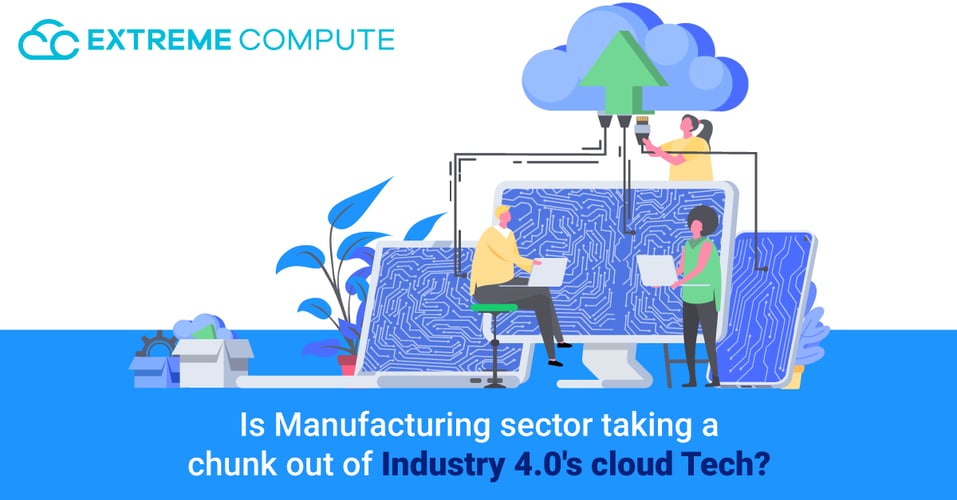Is Manufacturing sector taking a chunk out of Industry 4.0's cloud Tech?

Industry 4.0 is catching on due to recent advances in cyber-computing capabilities. AI, IoT, and other developments are closing the distance between the virtual and real worlds, which provides an interoperable interface between IT and physical operations. Cyber-physical realms are interconnected with state-of-the-art technologies to make up Industry 4.0. Companies would be able to exploit cloud infrastructure while keeping budget constraints in mind and converting initial investments (CapEx, capital expenditures) into recurring costs to the advantage of ROI.
How Industry 4.0 is adapting?
During the 18th century, a revolution in manufacturing started with the use of steam-generated power and mechanization of output. A century later, Industry 2.0 was developed with the advent of electricity and the conveyor belt assembly line. Also, in the latter part of the 20th century, memory-programmable controls and computers made their debut in the electronics industry 3.0. In the 4th industrial revolution, cyber-physical devices came together (smart machines able to share real-time information) to create Industry 4.0. The concepts of industry 4.0 include all modern technology such as cloud computing, IoT, artificial intelligence, big data science, drones, networking, and more.
Industry 4.0 cloud Tech
This advancement in processing power has allowed visualization and simulation techniques to flourish. With the help of cloud computing and cloud date storage solutions, products can be engineered and directly conveyed to the machines to follow. As a result, embedded systems, factories, and staff work together in a cyber-physical environment. AI and IoT backed robots are more mobile, making decisions in a factory environment. Augmented Reality (AR) is an advance on Virtual Reality (VR). True and digital environments are also merged to improve their virtual reality applicability. It overlays the data on the user's field of view to help him get a better picture of the object he is looking at like technical parameters, simulated machine parts etc.
In the Industry 4.0 initiative, different cyber-physical systems work together to make better decisions and increase productivity. To ensure uninterrupted system performance, timely alerts are produced indicating the predicted cause and maintenance needed. Cyber-physical device sensor information is stored on the cloud servers. In the cloud, artificial intelligence (AI) executes mathematical simulations to increase efficiency when directing the manufacturing process. Connecting vertically the hierarchies of a production line is needed for implementing Industry 4.0. Overall, the smart factory's knowledge is accomplished through the integration of information processing technology within a digital environment. Inefficiencies can only be dealt with after they have been detected and registered. We have a need to chart all development processes to equate the data collected using this tool with past data. Real-time monitoring helps you to dispatch warnings and notifications as well as activate automatic actions (such as shutting down machinery) when production faults or inconsistencies are found.
Industry 4.0: A Smart Factory example
To understand it on a fundamental stage, let’s take an example of a facility that shows how products and production equipment can interact using Shampoo bottles. Empty bottles will have RFID tags attached to them, and these tags decide which caps to use like different color of cap. During the manufacturing process, products are filled with digital product memory, which communicates with the surrounding environment through radio signals. This product reflects a fusion between the physical and virtual worlds.
The Indian view
For Industry 4.0, enabling policy structure and corresponding incentives have already been set up in India aiming at 2021 progress. The Smart Advanced Manufacturing and Rapid Transformation Hubs that fall under the Department of Heavy Industries (Ministry of Heavy Industries & Public Enterprises) are the country's initiative to drive for Industry 4.0 implementation in order to spread technical solutions to Indian manufacturing units by 2025. The government developed the approach to technology linked to Industry 4.0. The National Manufacturing Policy calls for increasing the share of manufacturing in GDP to 25% and Industry 4.0 is the only direction forward to accomplish this goal. This new age for manufacturing is going to revolutionize industries around the globe. It is important for manufacturers to think critically about emerging technology and integrate them into their processes to meet modern standards.
